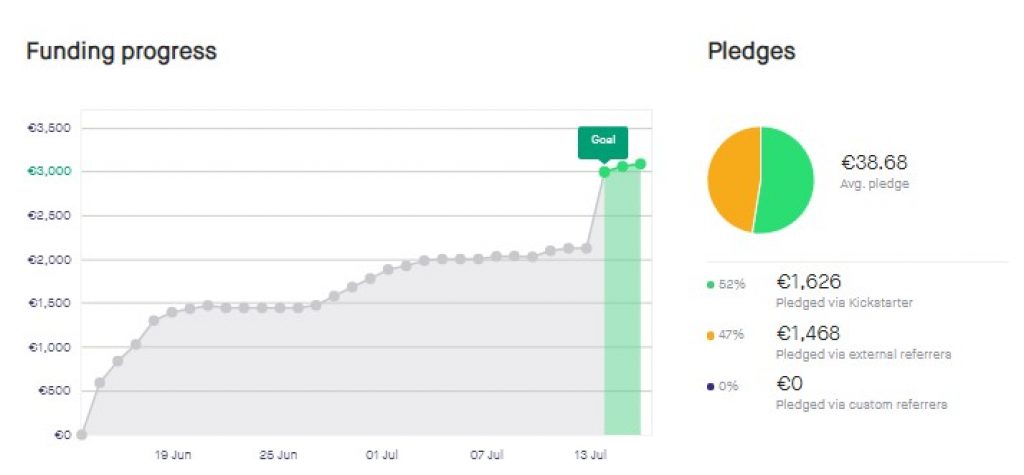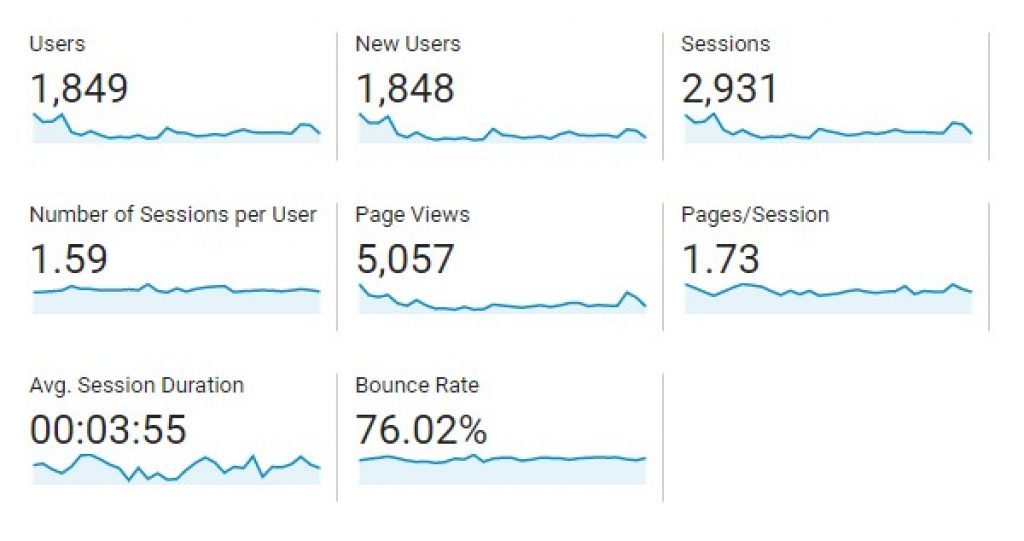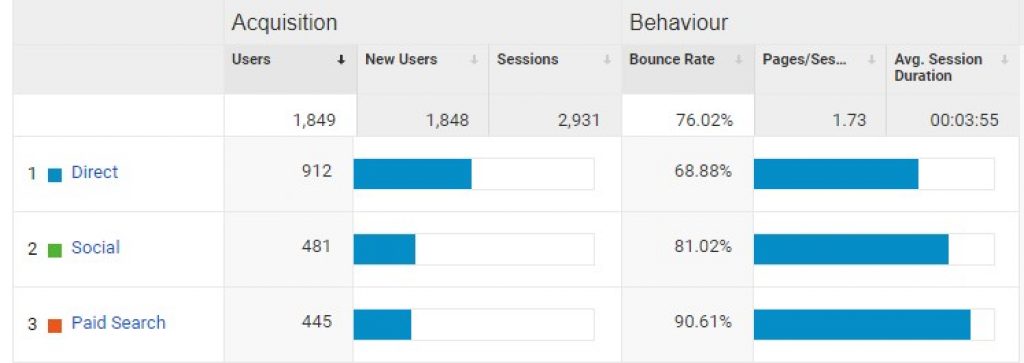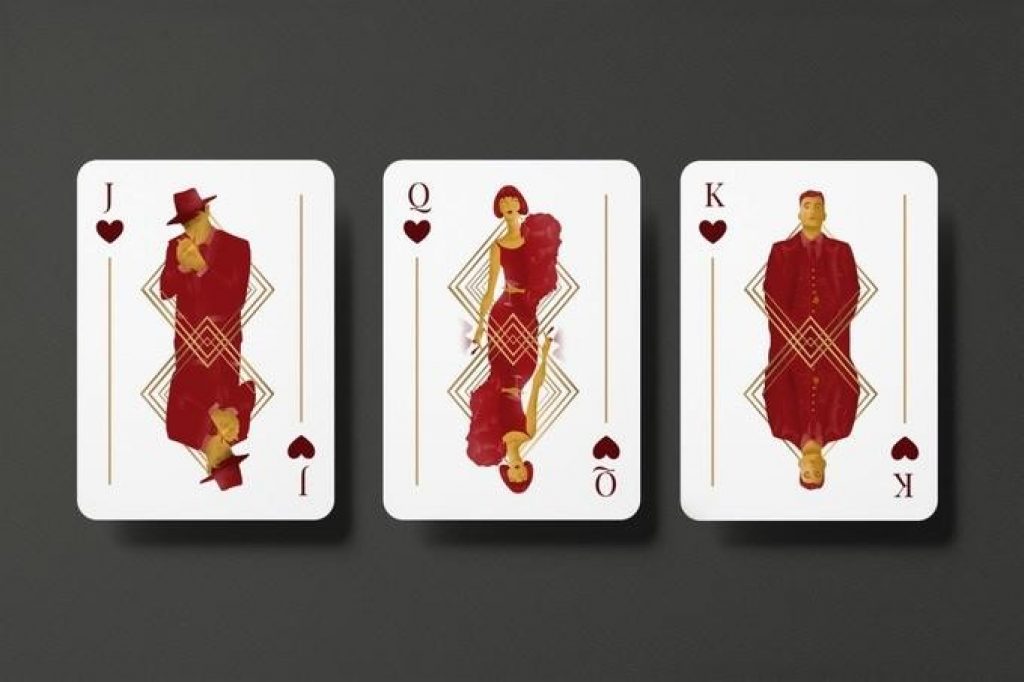Today I want to tell you the story of how I could launch a successful Kickstarter project, Colores de Colombia, a custom designed deck of cards, and of how it costed me $250 and 500 hours.
Kickstarter is an amazing tool for creators that don’t want to throw money in an idea yet to be proven.
And I want to talk about the emotions, the steps, the fear of failures, the biggest takeaways that I learnt during that time. And how, moving from that huge amount of hustle and very little money, we are slowly creating a brand that people start to recognize.
While I cannot guarantee that this article will allow you to launch a successful Kickstarter, hopefully you will be inspired to try that idea that has been going through your mind for a while. The single biggest obstacle you need to overcome is the fear of failure!

Table of Contents
1. Who I am
My name is Marco, and I am a business graduate who decided to quit normal office jobs and to hustle. On top of Lune Playing Cards, I am an Italian teacher online, and have slowly grown to be a digital marketing freelancer for several small businesses.
Therefore, yes, I am a business graduate. Was that necessary to launch a successful Kickstarter? Possibly, but I think I could have done it even without that education.
Among other things, I enjoy collecting. I am extremely fascinated, for instance, by how toys grow to be investible assets. Think about the trading cards we bought for a couple of bucks as kids, while some of them now are worth in the thousands. How does a secondary market emerge and evolve around these items?
This is all I started from. This is all I had.
2. Why I decided to launch a project
So, I have a business background and a general interest in hobbies and collectibles. These two aspects kept coexisting for a while before I came to the realization:
Why shouldn’t I do something?
I think this is a true epiphany for a huge amount of entrepreneurs. In hindsight, we keep bordering and toying with the thought of doing what we end up doing, to the point that is it entirely obvious; but it takes us a long time actually to see that we should do it.
Again, at this stage, it was just a general desire to do something. I did not know what it was going to be. Also, I am good at a few things, but generally really bad at drawing, that is the most crucial part of any collectible.
At that time, I had specifically gotten interested in the world of magic. I often have some Youtube videos playing in the background when doing boring work. I purchased a couple of decks. There it was.
2.1 Why did I chose playing cards?
First, it is a product I enjoy and collect myself. I cannot stress how important this was during the whole process. I have been on this for so many hours that, had I not enjoyed cards, I would have given up.
Second, collectibles tend to be an interesting market. Very often, some very big players make impossible competitors, but niches exist in which smaller players can survive. Let’s talk numbers: the MOQ for printing decks of cards is around 500 units, at $3.5 per unit – a production investment of $1750. The selling price of a custom-designed deck of cards with a small run is anywhere between $10 and $14. The margins are there; quantity does not need to be huge.
Finally, designing a deck of cards appeared to be easier than most other collectibles I had come across. Think boardgames: surely more profitable, but there are many more illustrations to deal with. The game strategy must be fine-tuned to the extreme. A deck of cards has 12 figures and a tuck box. How hard could it be? (Spoiler alert: much harder than I thought).
The last piece came into place when I moved to Medellín, Colombia. By traveling around the country, I quickly realized how many amazing places, cultures, animals, plants there are over here. How about celebrating them with a deck? There I had it!

3. Crowfunding as the perfect channel
I had the product in mind, far from being realized and also far from being able to realize it.
But I always believed a tad too much in my ability to learn and decided not to worry about it. I needed to put together a plan.
Some quick math told me that I needed:
- $1750 for printing the cards.
- $150 to print a couple of prototypes. Those things are expensive.
- $200 to toy with Facebook Ads. I did not expect it would be a good investment, simply to learn.
Without even talking about the design, I already needed over $2000. I did not have $2000.
The design had to be another $1000 AT LEAST on top and finding a cheap artist. And a couple of hundred dollars more for some professional pictures.
In short, way beyond my budget.
3.1 What options to get funding?
I went back to my college learnings: how does one get funding? Friends and family, loan. IPO. And crowdfunding.
I am now the biggest advocate for crowdfunding. How does it work? You set a funding goal and tiers for your product, usually cheaper than retail price. You set a campaign duration, 60 days maximum. Launch. If you hit the funding goal, you receive the money, produce, and fulfill. If your campaign fails, the money is returned to the backers, and nothing happens.
Think about it: you come up with something and try to sell it. If it does not work, you don’t produce it. If it does, you know EXACTLY how much to produce. It is a way to pre-sell. To have customers telling you the exact number of units to produce. Any multinational company would kill for such a tool.
The two biggest options out there are Indiegogo and Kickstarter. I studied both: how many projects did they have, how many about collectibles, how many failed, what was the biggest project ever, how many were running at the same time. Fees and services were very similar, it came down to which was the best fit for me, and Kickstarter won.
3.2 Getting to know Kickstarter
The website warns you straight away: less than 40% of projects get funded.
Also, over 60% of projects don't get funded.
And you have to consider that there are plenty of recurring creators that have such a huge and loyal following that they will not get funded. Chances for a new creator without experience nor audience to launch a successful Kickstarter are low.
The fees on Kickstarter are rather high, 8%, and some penny on each sale, about twice what Paypal or Shopify would charge you. But you don't need to have the product ready to ship when you sell, and you are given some organic exposure; as it turned out, more than I thought I would.
There is one last great thing about crowdfunding. You are not an entrepreneur: you are a creator. Backers will cut you a break much more quickly than they would with a multinational company. And they are real experts, people who actually go on the hunt for new projects, and happy and able to nudge you in the right direction with the endless, tiny decisions that you will need to take.
Am I saying that crowdfunding is the best way of starting a business? No, don't quote me on that. I am positive that other channels are more profitable. It is a good option worth considering for small creative projects, that is what I think.
4. Idea Development: the long way to a successful launch on Kickstarter
As I had the sales channel, I now needed to put together the actual deck of cards. That meant coming up with the design, writing a business plan to make all the small decisions that I had to make, contacting suppliers, putting together all the marketing.
The first bit of luck: my girlfriend is a graphic designer. We had just started going out when I mentioned my project, and she ended up designing everything for free. That was the one big cost that I needed to front before the campaign.
I then sat down and started doing what I consider my trade: calling people and crushing numbers. I found suppliers, asked for quotes, bargained a bit, put everything in a very complex Excel sheet and made many of the very small decisions I was mentioning before.
Just consider this: you set a funding goal, which includes shipping costs, but for you it is very different whether those shipping costs are 10% or 30% of the total. The average pledge size influences shipping costs (the bigger the pledge, the smaller shipping costs are) and the country of destination. How do you estimate these, and how do you set the best price? It is a complex iterative process with many variables that you need to optimize while having minimal information. How do you understand where the price best sits, whether at $11 or $13? That is, what is the price elasticity of playing cards lovers? Unclear.
It was important to go ahead and study the market, understand how the product should be and who the target backer was going to be, and what price to charge. I was going for a very specific sub-sub-niche, on top of playing cards enthusiasts: people living in Colombia, or who had traveled and fallen in love with Colombia, or Colombians living abroad. I searched a lot of Facebook groups, forums, subreddits, and any other option to gain exposure to these communities, and I started asking for feedback and sharing the idea.
If there is one takeaway, I would like to share in this article. Here it is: feedback is king. Always actively seek feedback.
I feel like a lot of entrepreneurs are worried about looking weak and insecure, or that someone is going to steal their idea. I disagree with both. Again, companies pay millions to have biased tests that give them some sort of idea about the public feel about the product. We can do it for free.
5. Tools I had to learn to launch a successful Kickstarter
I have always been a big fan of learning. This campaign was a great way to learn lots of new things.
First, my girlfriend was taking care of the graphic part, but I still needed to understand something about Illustrator to help with some small things and change things around. That is not an easy one to learn. You can see here the progression of our logo.
Second, social media are absolutely crucial. I am awful at social media. Instagram, in particular, is very widely used by card lovers. I put together the account, learned where to put hashtags, how often to post, about what topics; I understood a thing or two about how to have more reach. (If you are interested in following us, look up @luneplayingcards). If you want to launch a successful Kickstarter, you need to be on there, and to be good.
I sat down and started working with Facebook ads. I had never seen the website before, and if you tried to advertise online, you know how many targeting options you have, i.e., how easy it is to get it wrong.
5.1 Engaging with the community is the most important skill
The most important and the hardest of all, I needed to learn how to interact with the community. Each subgroup tends to develop a very own microculture that can be welcoming or, on the contrary, very hostile towards others. The way you ask for feedback in a forum about playing cards is very different from the way you ask for feedback in a specific group on Facebook.
After the campaign, the count of tools went up: I put together a WordPress Woocommerce website. I studied the basics of Cinema4d so that I am now able to put together the render of a deck I have not prototyped and save some money, or see if it works. The list goes on. The more tool and the better at them, the easier to launch a successful Kickstarter, or to start any business.
6. Launch: the moment of truth
Going live is one of the most brutal scenarios for the entrepreneur. The idea that was your baby, that you nurtured for months or years, is now out for everyone to judge in a couple of seconds.
The rule of thumb on Kickstarter is that the first 48 hours make or break your campaign, and the last 48 hours can give you a nice boost. Everything in between is mostly flat.
The first two days are crucial for two reasons: they tell Kickstarter whether it should push your project up in the ranking, and they tell backers whether they should pay attention to it. As human beings, we are very sensitive to the approval of others; if nobody backs a project, it most likely that a person that half liked it won’t either. Again, Kickstarter tells you the numbers to the last dollar!
Another fundamental concept I came to understand is that you want to share your project as much as you can. Some people will care, and a small percentage will pledge. Most people will not care. Very, very few people will absolutely love it. These are the ones you have to look for!
In my case, there was, in particular, an English professor from Canada, that I now call a friend, who went above and beyond to get the project to fund.
6.1 Learning and data from the launch: Kickstarter
As the project progresses, you can keep track of it. I had an Excel sheet with about 30 different places in which I was sharing, and I created a bit.ly link for each of those to have the exact numbers. Kickstarter also gives some interesting insight, and it can be hooked up with Google Analytics to study their numbers too. Here some data.

The most surprising, to me, was that over half of the backers found my project on Kickstarter. Instagram, Facebook, ads, spamming in groups accounted for the other less-than-half. Surely someone who saw the project shared by me went to look it up rather than clicking, as we know many do, but still, I find the number stunning.
Almost half of my backers were from the US. I expected that: it is the biggest, most receptive market for anything that you collect, and playing cards are no exception.
One of the information I was missing: shipping was a fourth of the total funds raised. Yes, Kickstarter counts the money that goes towards shipping as part of the contribution (and therefore, they get their cut on it too!). This is complemented by the fact that, as it can be seen in the previous image, the average pledge was at €38.68, or two and a half decks. (Shipping really was the hardest piece of the puzzle, and my estimation ended up being slightly more pessimistic but pretty close to the real number).
6.2 Learning and data from the launch: Analytics
Here some Analytics numbers:


1849 unique users over a month visited the campaign page. It may not sound like a huge number but think about it. That page did not exist before, it was most probably impossible to find on Google, and all the traffic was either driven by organic positioning on the Kickstarter search engine, or by social media, or by the few ads I had done. Here some more data:

Now, get this: half of my visitors were drawn in by organic searches on Kickstarter, and those had a bounce rate below 70% and an average session duration at a whopping five and a half minutes. If you ever looked at analytics, you know these are very healthy numbers.
Now, what does all of that mean?
It means that anyone can get a healthy amount of organic traffic on the platform that is actually interested in hearing you out. If you are an entrepreneur, you know this is the hardest bit to get that shot at making your sales pitch.
7. Results and Takeaways from the launch of a successful Kickstarter
What did I learn from running a successful Kickstarter project?
Money should not be the reason.
If you are in it for a quick win and to see profit immediately, this is not the place for you.
To launch a successful Kickstarter does not mean to turn a profit. Besides the number of skills that you need to have or develop, not even to consider the 500+ hours that my girlfriend and I put in it – we made €65 in profit. Sixtyfive euros. About ten cents an hour. Sure, we could have dropped a few grands in ads and turned a better profit, but I wanted to bootstrap it from zero.
Now. Approaching the release of our second project, after fulfilling correctly the first one, I see more interest. We are better known in this little world. We are more experienced and know some mistakes we will not make again. If we successfully get one or two more projects funded, we might go for something bigger and actually turn it into a full-time business.
If you have the patience, creativity and skills, crowdfunding is the best tools out there to bootstrap a business with zero money.
The importance of engaging with the community.
It is easy to underestimate how important the community is.
I mean it.
When crowdfunding a project, you are not looking at a market. You are looking at backers and supporters. You have a moral duty to be there for them. They are helping you getting something started.
If you manage to keep your head down and respectfully speak to them, they are a goldmine of information, help, and feedback.
If you don’t, they are going to destroy you.
And you need to engage with them on the right channel. It is different from asking for something on reddit, on a forum, or on your Instagram account, and you need to learn where you have to ask what.
If you ever are to have a shot at launching a successful Kickstarter, engage, engage, engage.
Pros and cons of bootstrapping with no capital
I decided to bootstrap without any money, mostly because I did not really have any money. We did everything in-house, and the only expenses were $150 to print two prototypes and $100 on Facebook ads testing.
The positive is that you are not risking money (duh). You can give it a shot, and if nobody cares, you only lost time. Also, there is something heroic about starting a venture on a shoestring that will have many people like and support you.
The negative is that it will take you much more time, and it will be lower quality. Take content creation for social media: I am slow and bad at doing it, and it surely takes me twice as long it would take someone half-decent to create a worse piece. I am seriously planning on hiring a content creator.
Friends and family are the most important audience
If you are a bit of an introvert like me, you have one dream: start something that does not have your name on it, turn it big, and nobody around you knows it is you. Why? Because the idea of failing in front of the people that know you hurts.
I have been to business school, and I know that there is a lot of gossip and envy going around. I am sure that, had I failed, many acquaintances would have been laughing about it.
However, you cannot make it without your friends and family.
Who is going to be the first person to land a hand, to share, to comment on your posts? Someone you knew from before. Always. You can’t make it alone.
And what is the big deal if some fake friend has something wrong to say about you failing? 90% of businesses fail, and inevitably you don’t fail if you don’t try. If you fail, you have learned many things that will make success a bit more likely next time.
You should embrace failure as a real possibility – and really, if there was no failure, would it be any good to succeed?
8. The future: after the first successful Kickstarter project
Launching our first successful Kickstarter campaign is not where this stops. We have plans to expand.
I think that a small brand like ours has the potential to run two successful Kickstarter campaigns per year. More, it is unlikely at this stage.

After many more hours of work, we are releasing on March 21st, our second project, Guns, Jazz & Whiskey – an homage to the 20s in New York City. It is a much more complicated project – as said, I learned how to render for this one. We moved to the best-known playing cards printer. I consider this campaign a significant improvement over the first one – you can check it out here.
I plan to outsource what I am not great at doing progressively. Instagram will be the first on the list. This way, I will have more time to focus on improving more strategical items and to work on more projects potentially.
I also plan on expanding the product range: I have a brand, I have a design, I had to incorporate, might as well start selling related products on Amazon and Etsy. Maybe small objects, such as calendars. We will need to look into it.And the biggest plan for the future is to keep hustling.








